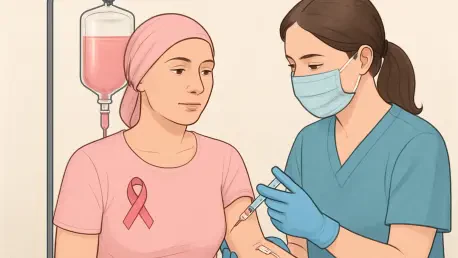Today, we’re thrilled to sit down with Ivan Kairatov, a renowned biopharma expert with a wealth of experience in research and development, particularly in the realm of innovative technologies in the pharmaceutical industry. With his deep understanding of cutting-edge treatments, Ivan is the perfect person to guide us through the exciting developments in breast cancer therapy, including Roche’s recent groundbreaking study. In this conversation, we’ll explore the details of a new experimental drug, the significance of its trial results, and what this could mean for patients and the future of cancer care.
Can you give us an overview of Roche’s recent Phase 3 study on breast cancer treatment and what it aimed to achieve?
Absolutely. Roche recently conducted a Phase 3 trial called evERA, which focused on evaluating a new experimental drug called giredestrant for a specific type of breast cancer known as ER-positive, HER2-negative. This is the most common form of breast cancer, often initially treated with hormone therapies and targeted drugs like CDK4/6 inhibitors. The main goal of the study was to see if combining giredestrant with another drug, everolimus, could delay disease progression or death compared to older hormone treatments paired with the same drug. It’s a critical area of research since many patients eventually progress after first-line treatments, and there’s a real need for effective second-line options.
What makes giredestrant unique as a treatment, and how does it fit into the broader class of therapies for breast cancer?
Giredestrant belongs to a class of drugs known as selective estrogen receptor degraders, or SERDs. These drugs are designed to not only block estrogen receptors, which fuel the growth of certain breast cancers, but also break them down, essentially removing the target that the cancer relies on. What’s exciting about giredestrant is that it’s an oral medication, making it more convenient than some older injectable treatments. Compared to other SERDs like those already on the market, it’s being tested to see if it can offer benefits to a wider range of patients, which could set it apart in terms of clinical impact.
Why did the researchers decide to combine giredestrant with everolimus in this trial?
The combination of giredestrant with everolimus, which is also known by its brand name Afinitor, was chosen strategically. Everolimus is already used in second-line treatment for ER-positive breast cancer because it targets a specific pathway that helps control cell growth, complementing hormone-based therapies. By pairing it with giredestrant, the idea was to create a dual approach—disrupting the estrogen receptor while also inhibiting cancer cell proliferation through another mechanism. This kind of synergy is often key in tackling resistant or progressing cancers.
The trial results showed a significant delay in disease progression. Can you walk us through the key findings?
Certainly. The results from the evERA trial were quite promising. For patients with ESR1 mutations—a genetic change that often develops after hormone therapy and makes the cancer harder to treat—the combination of giredestrant and everolimus reduced the risk of disease progression or death by 62%. In the broader group of patients, which included those with and without this mutation, the risk reduction was still impressive at 44%. Interestingly, for patients without the ESR1 mutation, the data wasn’t as conclusive in showing a clear benefit over older therapies, but there were still hints of improvement in other areas like response rates.
Beyond the numbers on disease progression, were there other benefits for patients that stood out in the study?
Yes, there were additional positive signals in the trial. For instance, the study showed improvements in response rates, meaning more patients saw their tumors shrink or stabilize. The duration of those responses was also encouraging, suggesting that the treatment could offer a meaningful window of control over the disease. There were even early indications of a potential benefit to overall survival, though these findings are still being analyzed. Collectively, these outcomes point to a regimen that could really make a difference in clinical practice.
How do these results stack up against other similar drugs already available for breast cancer patients?
When you look at other SERDs on the market, the results with giredestrant are quite competitive, especially because of the broader impact seen in the trial. Some of these other drugs have shown strong benefits primarily in patients with ESR1 mutations, with risk reductions in disease progression ranging from 38% to 45%. However, they haven’t consistently demonstrated an advantage across all patients, regardless of mutation status. Giredestrant’s ability to show a 44% risk reduction in the overall population tested is noteworthy and could position it as a more versatile option if these results hold up in further analysis and regulatory review.
Looking ahead, what could these findings mean for the future of breast cancer treatment and for patients hoping for better options?
These findings could be a game-changer for many patients with ER-positive, HER2-negative breast cancer, especially those who progress after initial therapies. If giredestrant gains regulatory approval, it could become a go-to second-line treatment, offering a convenient oral option that delays progression for a significant portion of patients. For doctors, it provides another tool to tailor treatments, potentially combining it with other therapies like everolimus to maximize impact. More broadly, it underscores the importance of developing targeted therapies that address specific resistance mechanisms, paving the way for more personalized cancer care.
What is your forecast for the future of SERD therapies in breast cancer treatment?
I’m very optimistic about the trajectory of SERD therapies. We’re seeing a wave of innovation in this space, with drugs like giredestrant pushing the boundaries of who can benefit from these treatments. I expect that over the next few years, we’ll see even more refined approaches—perhaps combinations with other novel agents or better ways to predict which patients will respond best based on genetic markers. The focus will likely shift toward expanding access to these therapies and ensuring they’re integrated into treatment guidelines, ultimately improving outcomes for a wider range of breast cancer patients.









